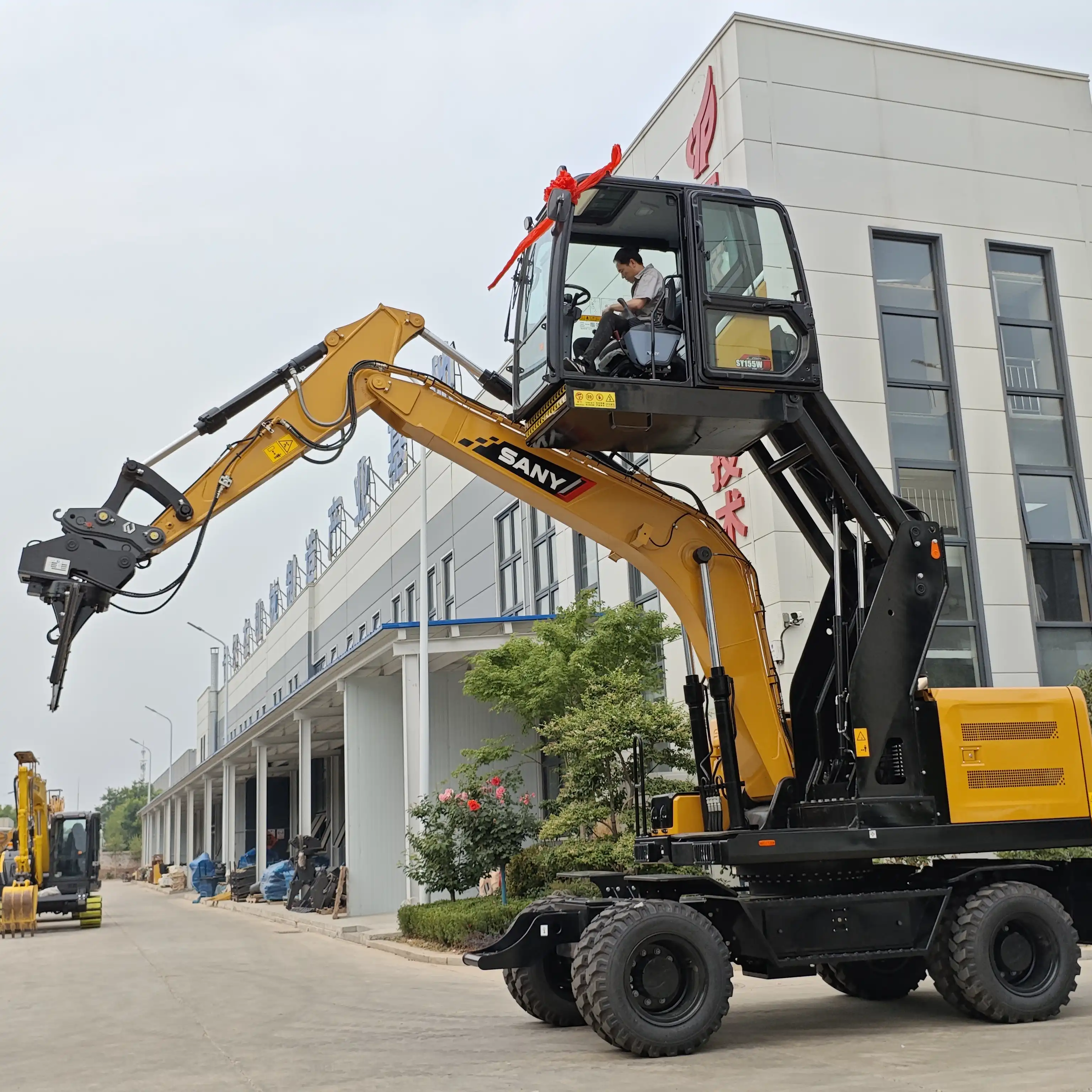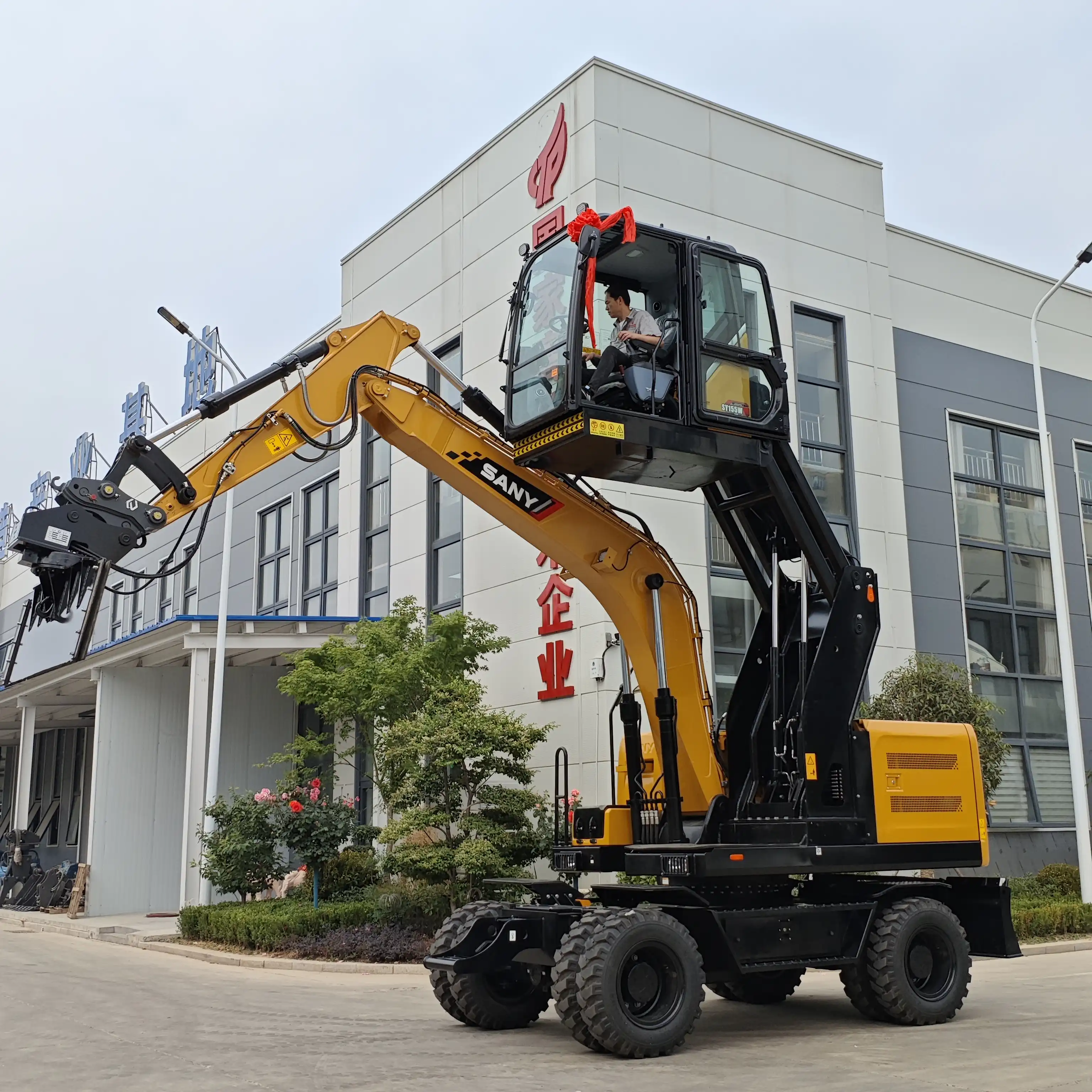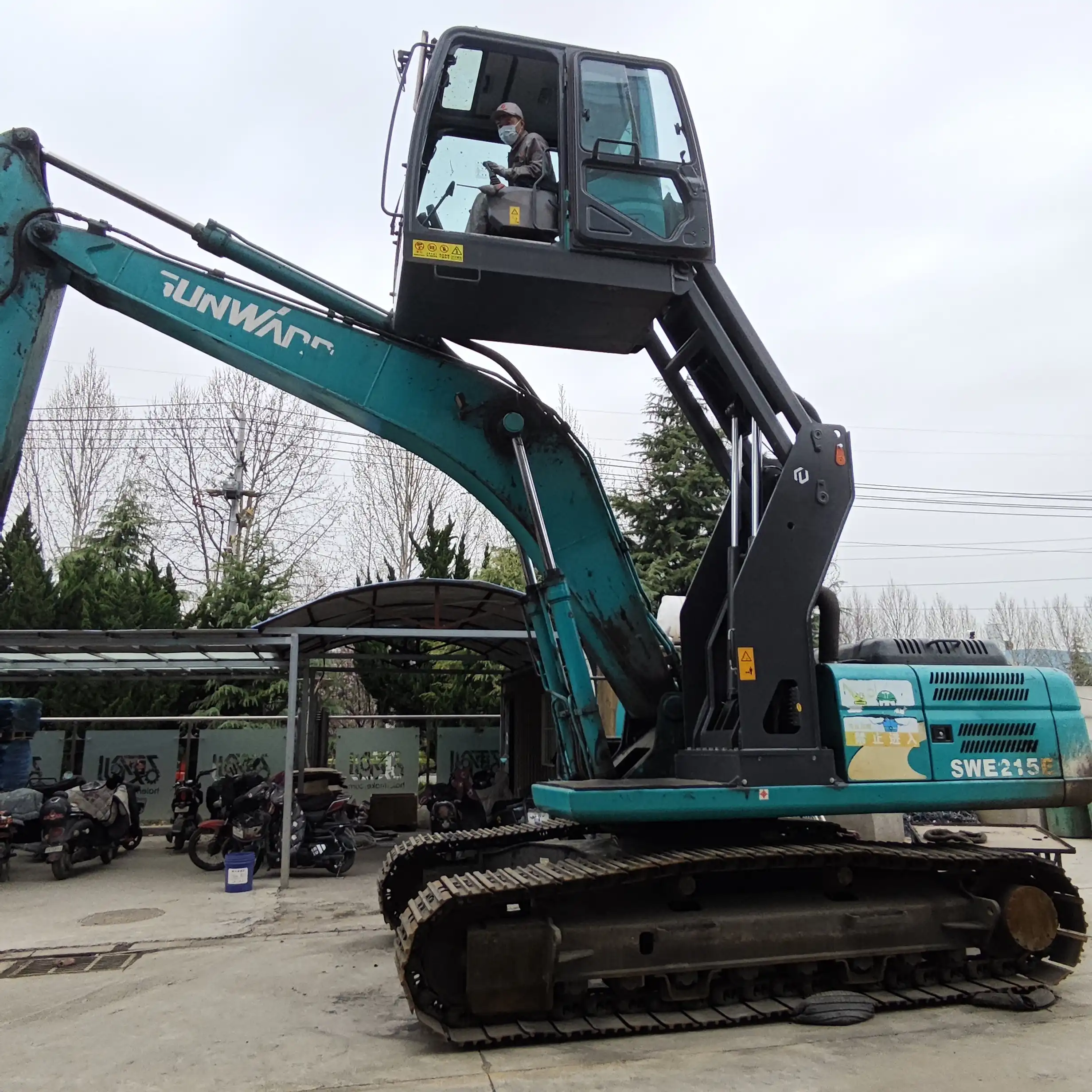Can an excavator cab unscrew itself?
An excavator cab cannot unscrew itself under normal operating conditions. The cab assembly is engineered with multiple redundant safety mechanisms and structural components specifically designed to prevent unintended detachment during operation. Modern cabs are secured to the machine's superstructure using a comprehensive system of high-tensile bolts, specialized locking mechanisms, and structural mounting brackets that work in concert to maintain cab stability even under extreme operational stress. These fastening systems are designed with vibration-resistant technologies that prevent gradual loosening over time, while regular maintenance protocols include torque verification procedures to ensure all mounting hardware maintains proper tension throughout the equipment's service life. The structural integration between the cab and machine frame represents one of the most thoroughly engineered safety features on modern excavation equipment, making spontaneous detachment virtually impossible without catastrophic mechanical failure or severe operator negligence.
Cannot Unscrew Itself

Engineering Safety Features
The concern regarding whether an excavator cab attachment might spontaneously detach from its mounting base represents a fundamental consideration in heavy equipment design. Modern excavator manufacturers employ comprehensive engineering strategies specifically aimed at preventing such potentially catastrophic failures. These safety systems incorporate multiple redundant features working in parallel to ensure cab attachment integrity under all operational conditions.
The primary attachment mechanism typically involves a pattern of high-tensile bolts, often ranging between 8-16 fasteners, depending on machine size and application environment. These specialized fasteners are manufactured from hardened alloy steels with minimum tensile strengths exceeding 150,000 PSI, providing substantial resistance against both lateral and vertical forces encountered during operation. The bolt pattern design distributes operational stresses across multiple attachment points, preventing load concentration that might otherwise compromise individual fasteners during dynamic operations like slewing or travel over irregular terrain.
Regulatory Compliance Standards
The integrity of excavator cab mounting systems falls under stringent regulatory oversight across major global markets. These comprehensive safety standards establish minimum performance requirements for cab attachment mechanisms while mandating specific testing protocols to verify compliance before equipment certification and commercial release.
Within European markets, the Machinery Directive 2006/42/EC and associated EN 474 standards establish specific requirements for operator protection systems, including detailed provisions regarding cab attachment integrity. These regulations mandate comprehensive testing, including dynamic stress evaluation, simulated rollover testing, and accelerated vibration exposure to verify long-term mounting security. Similar requirements exist under OSHA regulations in North American markets, with specific provisions outlined in OSHA 1926 Subpart P and related ANSI standards governing earth-moving equipment safety specifications.
Vibration Resistance Technologies
One of the most significant engineering challenges in maintaining excavator cab attachment security involves mitigating the effects of operational vibration that might otherwise contribute to gradual fastener loosening over extended operating periods. Modern equipment incorporates multiple specialized technologies specifically designed to address this potential concern.
Advanced fastener systems represent the first line of defense against vibration-induced loosening. Most manufacturers employ specialized locking washers incorporating wedge-action designs that automatically increase resistance as loosening forces intensify. These mechanical systems are often supplemented with chemical thread-locking compounds applied during assembly, creating a redundant protection strategy against unintended fastener rotation. Some manufacturers utilize specialized fasteners with prevailing torque features, mechanical designs that maintain constant tension regardless of vibration exposure, providing continuous resistance against loosening forces throughout the equipment's operational lifespan.
Structural Design

Integrated Mounting Systems
Modern excavator modification cab designs have evolved substantially beyond simple bolt-on attachments, moving toward sophisticated integrated mounting architectures that fundamentally enhance attachment security through structural integration. These contemporary designs incorporate the cab mounting interface as a core structural element rather than a simple mechanical connection, providing unprecedented attachment integrity under all operational conditions.
The foundation of integrated mounting systems typically involves a continuous structural frame element that extends from the counterweight through the superstructure and into the cab supporting framework. This unified structural pathway creates a continuous load-bearing path that distributes operational stresses across the entire machine structure rather than concentrating forces at discrete attachment points. The cab interface typically incorporates precision-machined mounting surfaces with multiple alignment features, including dowel pins, machined shoulder interfaces, and interlocking structural geometries that maintain precise positioning independent of fastener tension.
For applications in severe duty environments like mining operations, railway construction, or demolition projects, manufacturers often implement additional structural reinforcement at cab mounting interfaces. These enhancements typically involve increased material thickness at critical stress points, supplementary gusseting to resist torsional forces, and strategic reinforcement ribs designed to distribute dynamic loads across broader structural areas. Such comprehensive structural integration makes spontaneous cab detachment virtually impossible without catastrophic structural failure throughout the entire upper machine assembly.
Material Specifications
The materials employed in excavator cab mounting systems reflect careful engineering selection processes focused on long-term structural integrity under extreme operational conditions. These specialized materials dramatically exceed minimum strength requirements to ensure substantial safety margins throughout the equipment's service life, even when subjected to unpredictable stress events.
Mounting brackets and structural interface components typically utilize high-strength low-alloy (HSLA) steels with yield strengths exceeding 70,000 PSI. These specialized metals offer exceptional resistance to both static and dynamic loading while maintaining ductility characteristics essential for absorbing impact forces without brittle failure. Critical components often undergo additional heat treatment processes to enhance fatigue resistance—a critical consideration for components subjected to millions of vibration cycles throughout their operational lifespan.
Fastener systems incorporate even more specialized metallurgical compositions, typically utilizing alloy steels with tensile strengths exceeding 150,000 PSI. These high-performance fasteners undergo precision manufacturing processes, including thread rolling rather than cutting, creating continuous grain structures that dramatically enhance fatigue resistance compared to conventional threaded components. Surface treatments, including zinc-nickel plating or specialized phosphate coatings, provide additional corrosion protection, preventing degradation that might otherwise compromise long-term structural integrity in challenging operational environments.
Locking Mechanisms

Mechanical Locking Systems
Beyond basic fastener systems, modern excavator cab attachment designs incorporate specialized mechanical locking mechanisms specifically engineered to prevent unintended loosening even if primary fasteners experience tension reduction. These redundant security systems provide additional protection against the theoretical possibility of gradual loosening over extended operational periods.
The most common mechanical locking approach involves split-pin or cotter-pin systems integrated with castle nuts on critical fasteners. This arrangement physically prevents fastener rotation once properly torqued, creating a mechanical interference that remains effective regardless of vibration exposure or tension changes. For applications involving particularly severe vibration profiles, some manufacturers employ specialized wedge-lock systems that automatically increase resistance if loosening begins, providing progressive resistance proportional to the loosening force encountered.
Advanced equipment designs often incorporate supplementary mechanical interference features independent of threaded fasteners. These systems typically involve precision-machined components with interlocking geometries that physically prevent component separation without intentional alignment during disassembly. Such mechanical interference designs provide a secondary safety barrier completely independent of fastener systems, ensuring cab retention even in the theoretical scenario of complete fastener failure across multiple attachment points.
Chemical Thread-Locking Compounds
Contemporary assembly methodologies for excavator cab mounting systems frequently incorporate specialized chemical thread-locking compounds that provide molecular-level resistance against unintended fastener loosening. These advanced materials create powerful chemical bonds between mating threads, preventing microscopic movement that might otherwise initiate gradual loosening under vibration exposure.
Professional-grade thread-locking compounds typically incorporate methacrylate ester formulations that remain liquid during initial application but polymerize upon metal contact in anaerobic conditions (absence of oxygen between mating threads). The resulting polymer chains create mechanical interference between thread surfaces while filling microscopic imperfections that might otherwise allow incremental movement. Different formulation strengths accommodate various application requirements, from medium-strength compounds allowing future maintenance disassembly to permanent grades requiring thermal decomposition for removal.
For critical applications in extreme environments like mining operations or demolition projects, manufacturers often implement specialized high-temperature thread-locking compounds capable of maintaining effectiveness even when subjected to elevated temperatures from nearby hydraulic components or engine heat. These specialized formulations maintain molecular bonds even at temperatures exceeding 450°F (232°C), providing continuous protection against vibration-induced loosening regardless of operating conditions or ambient environmental factors.
FAQ
①What signs indicate potential loosening of excavator cab mounting hardware?
While an excavator cab detaching completely is virtually impossible without catastrophic failure, early warning signs of mounting system issues may include unusual cab movement during operation, increased vibration transmitted to the operator station, audible metallic sounds during machine articulation, or visible gaps developing at mounting interfaces. Equipment operators should immediately cease operation and request professional inspection if such symptoms appear, as they may indicate maintenance requirements beyond routine service intervals.
②How often should excavator cab mounting bolts be inspected and retorqued?
Professional maintenance protocols typically recommend visual inspection of excavator cab mounting hardware during daily pre-operation checks, with comprehensive torque verification at 500-hour service intervals for most applications. Equipment operating in severe environments or high-vibration applications may require more frequent verification, potentially as often as 250-hour intervals. Always follow manufacturer-specific guidelines, as requirements vary based on machine design and intended application environment.
③Can aftermarket modifications compromise excavator cab attachment security?
Unauthorized modifications to excavator cab structures, mounting systems, or surrounding components can potentially compromise the engineered safety systems that prevent unintended detachment. Any alterations involving additional equipment mounting, structural changes, or attachment point modifications should only be performed under engineering guidance from the original equipment manufacturer or certified third-party engineers with specific expertise in heavy equipment structural design.
About Tiannuo

The question of whether an excavator cab can spontaneously unscrew itself addresses a critical safety consideration in heavy equipment operation. Based on comprehensive engineering analysis, modern equipment designs, and industry safety standards, we can definitively conclude that such an occurrence is virtually impossible under normal operating and maintenance conditions. Multiple redundant safety systems, including specialized fasteners, chemical thread-locking compounds, mechanical interference features, and structured inspection protocols, work in concert to ensure cab attachment integrity throughout the equipment's operational lifespan.
For operators, fleet managers, and maintenance personnel in construction, railway maintenance, and mining sectors, understanding these sophisticated safety systems provides valuable operational context while reinforcing the importance of following manufacturer-recommended inspection and maintenance schedules. While spontaneous detachment represents an extraordinarily unlikely scenario, adherence to professional maintenance protocols provides additional verification of continued system integrity throughout the equipment's service life.
Tiannuo Construction Machinery specializes in manufacturing high-quality excavator components engineered to meet or exceed all international safety standards regarding structural integrity and operational reliability. Our products incorporate premium materials, including high-strength alloy plates, precision-machined fasteners, and advanced engineering designs to ensure maximum safety and durability across diverse operational environments. For additional information about our product specifications or customization options for specialized applications, please contact our engineering team at rich@stnd-machinery.com.
References
International Organization for Standardization. (2024). ISO 10262:2024 - Earth-moving machinery - Hydraulic excavators - Laboratory tests and performance requirements for operator protective structures. Geneva, Switzerland: ISO Central Secretariat.
Society of Automotive Engineers. (2023). SAE J1356: Commercial Vehicle Cab Mounting Performance Requirements. Warrendale, PA: SAE International.
American Society of Mechanical Engineers. (2024). ASME B30.5-2024: Mobile and Locomotive Cranes - Safety Standard for Cableways, Cranes, Derricks, Hoists, Hooks, Jacks, and Slings. New York, NY: ASME.
European Committee for Standardization. (2023). EN 474-5:2023 Earth-moving machinery - Safety - Requirements for hydraulic excavators. Brussels, Belgium: CEN.
Construction Equipment Manufacturers Association. (2024). Technical Handbook for Heavy Equipment Safety Systems and Component Testing. Chicago, IL: CEMA Publications.
About Author: Arm
Arm is a leading expert in the field of specialized construction and railway maintenance equipment, working at Tiannuo Company.

